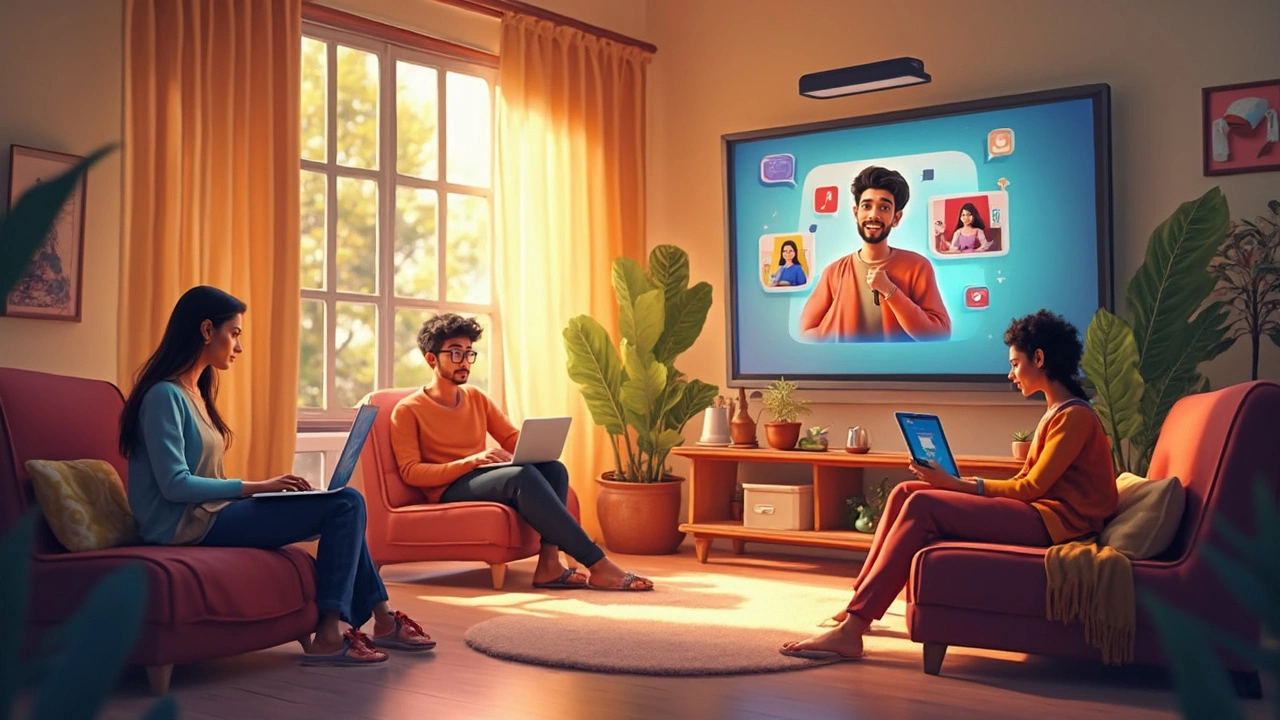May
20

- by Dhruv Ainsley
- 0 Comments
You hear a lot about online courses, but eLearning isn’t just one thing. It’s like going to the gym: you can take a group class, work with a trainer, or just do your own thing on the treadmill. The way you learn online isn’t always the same either—and the right fit makes a huge difference in how much you actually get out of it.
Not all eLearning styles work for everyone. Picking the right type can save you from wasting hours on stuff that just doesn’t stick. The cool part? Once you figure out which kind fits you, you can actually look forward to learning new skills, not just grind through boring videos. Let’s break down the core types so you can see what’s out there.
- Why eLearning Types Matter
- Self-Paced eLearning: Learn at Your Speed
- Instructor-Led eLearning: Real-Time Support
- Blended eLearning: Best of Both Worlds
- Picking the Right Type for You
- Tips for Getting the Most from eLearning
Why eLearning Types Matter
If you ever felt lost in an online class, you’re not alone. Choosing the right eLearning types is a big deal because it shapes how well people absorb information, keep up with lessons, and actually get to the finish line. Different approaches work for different folks—and research backs this up.
Here’s the thing: a 2023 Gallup digital learning report found that 54% of adults taking online courses dropped out before finishing, often just because the format didn’t match their lifestyle or learning preference. That’s a lot of wasted effort! Understanding the different eLearning styles lets you cut through this frustration and find what really clicks for you.
Schools and workplaces have picked up on this, too. Most major e-learning platforms—think Coursera, Udemy, or LinkedIn Learning—offer all three core types to reach more learners. That’s smart, because people want flexibility. For example, parents might like self-paced modules, while someone who wants instant answers might go for live group sessions.
Check how usage breaks down across popular platforms:
| Platform | Self-Paced (%) | Instructor-Led (%) | Blended (%) |
|---|---|---|---|
| Coursera | 62 | 28 | 10 |
| Udemy | 78 | 15 | 7 |
| Zoom Classes | 20 | 73 | 7 |
The numbers make it clear: more options mean more people can find their groove. If you pick a type that really lines up with your schedule and personality, you’re way more likely to finish a course and remember what you learned. That’s a win no matter why you’re studying.
Self-Paced eLearning: Learn at Your Speed
Self-paced eLearning is exactly what it sounds like: you decide when and how quickly you get through the material. No schedules, no waiting for others, and no pressure to rush through a lesson you haven’t quite nailed yet. You get 24/7 access to all your content, which is the biggest win for anyone juggling work, family, or a weird schedule.
This eLearning types option is probably what most people picture when they think of platforms like Coursera, Udemy, or LinkedIn Learning. The course is laid out with recorded videos, slides, hands-on challenges, quizzes, and often short readings. You work through it all at your own pace, hitting pause or replay whenever you need. Big fact here: studies from Harvard have shown self-paced learners tend to stick with courses around 30% better when they can control their own learning schedule.
If your attention span isn’t built for three-hour Zoom calls, this is usually the best match. You can watch a quick module over breakfast or squeeze in a ten-minute practice session on the subway. The downside? You don’t get real-time answers or instant feedback. You’ve got to motivate yourself—nobody’s checking if you actually finished that lesson.
- Best for: Busy adults, independent learners, and people who need flexibility.
- Watch out for: Losing focus or putting off lessons—set a schedule or use reminders.
- Tip: Stick with courses that offer quizzes, projects, or progress trackers to help you stay on track.
One more cool tip: Join course discussion boards. Even though it’s self-paced, jumping into the community or asking questions in forums helps make the experience interactive, not just you versus your laptop.
Instructor-Led eLearning: Real-Time Support
Instructor-led eLearning takes the best parts of a live classroom and puts them online. You’re not just watching lessons alone—you're in a virtual classroom with a real teacher and classmates. Platforms like Zoom, Microsoft Teams, and Webex make this possible, and it's exploded in popularity since 2020. According to a 2023 LinkedIn Learning report, 70% of companies say they offer instructor-led training online as part of their learning programs.
This style means you can ask questions in real-time, get instant feedback, and actually talk things through when you hit a wall. It’s not just lecturing—classes often feature discussions, breakout rooms, and even quizzes or polls. That keeps things interesting and helps stuff actually stick in your mind.
| Key Feature | What You Get |
|---|---|
| Live Q&A | Quick answers to your questions, right when you need them |
| Group Work | Team projects and collaboration, just like in-person |
| Deadlines | Set times to show up—great if you need a routine |
| Instant Feedback | Get corrections, encouragement, or advice from the instructor on the spot |
People who want accountability or struggle to focus often do better with this type of eLearning. It works especially well for technical topics, languages, or anything where practicing together helps. Some well-known platforms that use this approach include Coursera (for live cohort-based courses), Udemy Business, and Skillshare for live workshops.
There are a few things to watch out for. You’ve got to show up on time. If your schedule’s packed or you’re working across different time zones, that can be tricky. Plus, sometimes tech glitches can get in the way. But if you thrive on routine and want direct support, instructor-led eLearning types are hard to beat.

Blended eLearning: Best of Both Worlds
Blended eLearning takes what works from online learning and combines it with real-life, face-to-face experiences. This setup isn’t just a trend—more than 70% of US schools used some form of blended learning in 2023, and tons of companies are now moving in this direction too. Why? Because when you blend, you actually keep people more engaged and help them learn better. It’s not just sitting behind a screen, but it’s not all classroom lectures either.
So how does this mashup look in real life? It could mean doing some course modules or homework online, then turning up for a live workshop, discussion, or even a project with other people. Some popular learning platforms mix things up by offering short video lessons paired with weekly check-ins or live Q&A sessions. Others might throw in group challenges or team projects so you’re not just learning alone in your room.
Here’s what blended eLearning types usually involve:
- Online videos and readings for the basics, so you can go at your own pace.
- In-person (or live online) classes for real-time feedback, group work, and problem-solving.
- Interactive quizzes or assignments you do online between sessions.
One of the biggest upsides? Studies show people remember up to 60% more from blended learning compared to just online videos. That’s because you get repetition, mix up how you learn the info, and can actually ask questions if something’s not clicking. Plus, it fits busy schedules since you can do chunks on your own and just show up for the important live stuff.
| Feature | Blended eLearning | Pure Online Learning |
|---|---|---|
| Interaction | High (face-to-face & online) | Mostly online, limited real-time |
| Flexibility | Some schedule required | Fully flexible |
| Engagement | Higher (more social) | Depends on self-discipline |
| Completion Rate | Often above 70% | About 15-40% |
If you need help staying motivated, or you just like bouncing ideas off others, blended eLearning could be your sweet spot. The mix gives you structure but still lets you learn in a way that fits real life, not just theory.
Picking the Right Type for You
Feeling stuck on what kind of eLearning fits you? You're not alone. There's a reason some people drop out of online courses halfway through—it's often because the style just doesn't match how they like to learn or their schedule.
If you want something flexible, self-paced eLearning is your go-to. You control the speed, days, and even where you do your lessons. Busy parent? Shifting work schedule? Self-paced lets you log in at midnight or on your lunch break. According to a 2023 LinkedIn Learning report, 58% of professionals prefer self-paced formats for this exact reason.
Now, if you do better with regular face-to-face (or webcam-to-webcam) check-ins, instructor-led eLearning is worth a shot. You get real-time feedback and can actually ask questions on the spot. In fact, a recent study found that completion rates for live classes are up to 35% higher than for self-paced ones because folks are less likely to skip sessions when they’ve got someone waiting for them.
For people who want the structure but also flexibility, blended eLearning is kind of like the best of both. You get online videos or reading, but there's also a schedule with either live meetings or interactive assignments to keep you on track. Some university programs now run totally on this model, and it’s growing—about 50% of US higher education courses include some blended element, based on Education Data Initiative numbers from 2024.
| eLearning Type | Best For | Challenges | Completion Rate (%) |
|---|---|---|---|
| Self-Paced | Busy, independent learners | Low motivation, easier to procrastinate | 30-40 |
| Instructor-Led | People who need interaction & guidance | Fixed schedules, less flexibility | 65-75 |
| Blended | Learners wanting both structure & independence | May require travel to in-person sessions | 50-60 |
So, how do you actually choose? Ask yourself:
- Do I need a set schedule, or do I prefer learning anytime?
- Do I get more out of group discussions or am I fine figuring things out solo?
- Am I motivated enough to finish a course without someone checking in on me?
- Does my job, school, or personal life get in the way of attending live sessions?
Don’t just pick based on what sounds good today. Try out a short free course in each format to see which feels right. A lot of eLearning types now offer trial periods or demo lessons, so you can test the waters before you commit.
Tips for Getting the Most from eLearning
eLearning sounds easy at first—log in, watch a video, done. But anyone who's fallen down the YouTube rabbit hole knows staying focused isn't always simple. Here’s what actually works if you want to squeeze the most value out of any eLearning types.
- Set a schedule: Treat online learning like a real class. Pick specific days and times, block them on your calendar, and don’t hit snooze if your phone reminds you.
- Dedicate a space: Try to study in the same spot, whether it’s your kitchen table, a favorite coffee shop, or a quiet corner. It helps your brain shift into learning mode faster.
- Turn on your camera for live sessions: Studies from Stanford show that students who keep cameras on stay more engaged and remember more. Even if it feels awkward, it works.
- Chunk content: Break big modules into smaller tasks. Do one lecture or quiz at a time, then stretch or grab a snack. This helps memory stick better and fights screen fatigue.
- Find your hype squad: If possible, join forums or chat groups tied to your course. Sharing ideas or just venting about tricky assignments keeps you plugged in and less likely to give up.
If you’re still not convinced it’s worth the hassle, check this out: according to a 2023 LinkedIn Learning report, people who schedule their study time and interact on course forums finish at a rate 30% higher than those who don’t.
| Habits | Completion Boost |
|---|---|
| Study on a schedule | +20% |
| Active forum use | +30% |
| Video camera on | +15% |
One last thing: don’t forget to reward yourself when you finish a section or nail a quiz. Grab your favorite snack, take a quick walk, or just chill for a bit. Little wins keep your motivation high and make the next session easier to start.





